#Duchy of Brabant
Explore tagged Tumblr posts
Photo
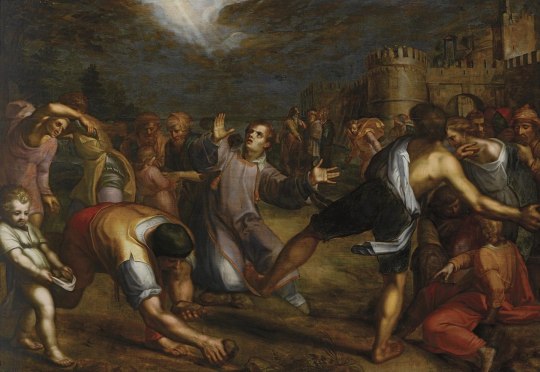
Martirio di Santo Stefano
by Denys Calvaert (Brabantian, c. 1540 – 1619) oil on panel (198 × 140), c. 1610
Wallraf-Richartz Museum
#737788064461684736/BUWkiIob#Denys Calvaert#Catholic Church#St Stephen Protomartyr#Monarquía Hispánica#Spanish Empire#Spanish Netherlands#Duchy of Brabant#17th century#Baroque#Museo del Prado#December 26th#martyrdom#oil on canvas#sacred art#paintings
8 notes
·
View notes
Text

Charles V by Albrecht de Vriendt.
#kingdom of belgium#duchy of brabant#haus habsburg#full length portrait#county of flanders#charles v#holy roman emperor#heiliges römisches reich#holy roman empire#austria#maison de habsbourg#albrecht de vriendt
7 notes
·
View notes
Photo

Achilles onder de dochters van Lycomedes
by Jan Boeckhorst (Munstrian, c. 1604 – 1668) oil on canvas (179,5 × 129,5 cm), c. 1650
Muzeum Narodowe w Warszawie
#Jan Boeckhorst#Achilles#Hispanic Monarchy#Duchy of Brabant#17th century#1650#Baroque#Greek mythology#Ovid#Muzeum Narodowe w Warszawie#oil on canvas#paintings
1 note
·
View note
Text
The Golden Age of Dutch painting: a Prelude
Portrait of Susanna Lunden (née Fourment) or Le Chapeau de Paille, by Peter Paul Rubens (The National Gallery, London) Suzanne Fourment Lunden, portrayed above, was Baroque Flemish artist Peter Paul Rubens‘s sister-in-law. In 1630, four years after Rubens’s first wife, Isabella Bran(d)t, died of the plague, fifty-three-year-old Rubens married sixteen-year-old Hélène Fourment. His first marriage…

View On WordPress
#Antwerp#Dutch Golden Age of painting#Eighty Years&039; War#Flanders#Flemish Baroque artist#Hélène Fourment#History#Peter Paul Rubens#Suzanne Lunden#The Burgundian State#The Duchy of Brabant#Twelve Years&039; Truce
1 note
·
View note
Text
Why George Russell's Disqualification is Really Napoleon's Fault
Alright motorsports fans, with the end of the Belgian Grand Prix (held before the summer break this year because the F1 calendar is becoming increasingly cursed year after year) F1 enters its summer break. NASCAR and Indycar are on an Olympic break thanks to both series currently being on NBC (who is the US broadcaster of the 2024 Paris Olympics), and MotoGP doesn't come back from its second summer break until next week.
So what the hell am I going to talk about in this blog.
Well, George Russell won the 2024 Belgian Grand Prix until he got disqualified for having an underweight car. Some people have theorized that Mercedes made a mistake and underfueled him, others have said that George switching to a one-stop meant he lost out of valuable pitlane speed time, using up more fuel, still others have theorized it's down to the unique procedures at Spa - where drivers turn around after turn one and drive the wrong way into pit exit - that meant Russell didn't have the chance to pick up rubber and thus increase the weight of his tyres.
I, meanwhile, have a different theory.
George Russell could only have been disqualified from the Belgian Grand Prix because of Napoleon!
Yes, really.
How, you may ask? Well, the Napoleonic Wars created the conditions that ultimately allowed for the the Circuit de Spa-Francorchamps to exist. Thus, the long lap that causes F1 cars to deliberately underfuel for the race, the unique post-race procedures due to track length, and choice of this area as the venue for the Belgian Grand Prix...none of that would've been possible with Napoleon.
Our story, as all good motor racing stories do, begins in 651 when the Benedictine Monk, Saint Remaclus of Stavelot founded the dual Abbeys of Stavelot and Malmedy (which you may recognize from corner names of the Spa-Francorchamps circuit, as these are neighboring villages).
These abbeys wound gain more territory in 747 when Carloman, the Majordomo of the Franks and uncle of Charlemagne, abdicated and became a monk himself.
They would be enlarged again in 882 by Charles the Fat, Holy Roman Emperor, in compensation for the Normans raiding and burning down both abbeys the previous year.
Thus, the Princely Abbey of Stavelot-Malmedy became one of the many mosaic pieces of the complex historical mindscrew that is the Holy Roman Empire, holding territories along what is now the Belgian-Germany border. Back then though, they were a rather significant ecclesiastical territory, holding land where Lothringia met the Low Countries.
This was the exact region where, in the late 15th and early 16th century, the Dukes of Burgundy attempted to create their own sovereign territory, using the chaos of the Hundred Years War in France to become lords over Luxembourg, Hainaut, Flanders, Brabant, and Holland. Soon enough, the Princely Abbey of Stavelot-Malmedy was one of only three independent states remaining in the region.
It was Stavelot-Malmedy, an ecclesiastical state which thus couldn't easily be absorbed into secular Burgundy.
Then the Prince-Bishopric of Liege, which again, was an ecclesiastical state which meant it would be a tricky proposition for a Catholic Duke of Burgundy to try and conquer.
And finally the Duchy of Bouillon, which was a downright weird state in that the title was a secular Duchy that was sold to the Prince-Bishopric of Liege, and in the late 17th century became a sovereign possession of the La Tour d'Auvergne, a French noble family.
In any case, upon the death of the Burgundian line, their territories were divided between France, the feudal overlord of Burgundy, and Philip the Handsome (the son of Mary the Rich, the last Duchess of Burgundy, and Maximilian von Habsburg, an Austrian Prince).
Philip the Handsome was in turn married to Joanna the Mad (we should bring back the random ass nicknames people used to get in the past btw), the Queen of Castile and Aragon. Their son, Charles, would thus inherit Spain, the Burgundian possessions in the Low Countries, and, eventually, Austria and the title of Holy Roman Emperor. Yeah.
So thanks to Charles V rolling a natural 20 in his birth dice roll, Stavelot-Malmedy was suddenly one small little ecclesiastical holding squeezed between the two halves of what would eventually become known as the Spanish Netherlands.
Then, the northern half of the Spanish Netherlands decided they didn't want to be Catholic anymore. This ushered in the Dutch Revolt of the 17th century, a bloody religious struggle concurrent with the Thirty Years War and the Portuguese War of Independence that marked the end of the golden age of Spanish power.
Come 1700 and Charles II of Spain (Charles V was Charles I in Spain, regnal numbers get weird when you rule over half of Europe), the last Habsburg King of Spain, dies an inbred and infertile mess. The Low Countries become a battleground in the War of the Spanish Succession.
On one side, France and Spain, as Charles II had declared his grandnephew, the French Prince Philip of Anjou, threatened to tip the scales of western Europe towards the Bourbon dynasty.
On the other side, a grand coalition of Austria, England, the Dutch Republic, Prussia, Portugal, and Savoy aimed to contain French power.
This was the War of the Spanish Succession, and the war would be transformative for the southern Low Countries. The Spanish Netherlands went back to Habsburg hands and became the Austrian Netherlands, meanwhile, the Duchy of Cleves, just to the east, was returned to Prussia following a French occupation.
The Dutch Republic in the north was Protestant, the Austrian Netherlands were Catholic, and Protestant Prussia was emerging on the scene as well. This would more or less lay the stage for the Napoleonic Wars, where the armies of the French Republic and later the French Empire would occupy all of this land. Gone were the Austrian Netherlands, gone was Stavelot-Malmedy, Liege, and Bouillon, and gone was Prussian Cleves.
Instead, the land surrounding Spa-Francorchamps would became part of the French Department of Ourthe, named for one of the principal rivers of the region.
However, much like the War of the Spanish Succession, numerous grand coalitions would rise up against Napoleon, the primary participants being Great Britain, Austria, Prussia, the Dutch, and Russia. In 1815, they would finally defeat Napoleon once and for all, and the Peace of Vienna would shape the new postwar Europe.
Of the old Princely Abbey of Stavelot-Malmedy, Stavelot would go to the United Kingdom of the Netherlands (the new kingdom combining the modern-day Netherlands, Belgium, and Luxembourg), while Malmedy would go to the Kingdom of Prussia.
The border would be a minor tributary of the River Ambieve known for its reddish water. The name? Eau Rouge.
Fast forward to 1830 and the largely Catholic southern Netherlands revolt from their Protestant overlords in the north and demand the creation of a Kingdom of Belgium. Following a great power conference in London, the Belgians would get their wish, and in 1831, the Kingdom of Belgium was born, including Stavelot.
The Dutch would recognize Belgium Independence in 1839.
Eau Rouge was now the Belgian-Prussian border.
Come 1871, and Prussia becomes the German Empire.
Come 1914, and this border region is amongst the first overrun by the Germans in World War I. Spa becomes a major German field hospital from the get-go, and by 1918, Spa is the German military headquarters and the primary residence of Kaiser Wilhelm II.
Upon the German surrender in 1918, Kaiser Wilhelm would abdicate and leave for the Netherlands, meanwhile, France and Belgium - the countries that wore the greatest scars from World War I - would demand harsh reparations from Germany. For Belgium, this would include Eupen-Malmedy.
Thus, the great majority of the old Princely Abbey of Stavelot-Malmedy was now within Belgian borders.
Jules de Thier, owner of the La Meuse newspaper in Liege, found this new territory to be the perfect site for a high-speed triangular race track in 1921. The race would begin in old Belgium, with a run to the old border - originally they would veer right, pass through Ancienne Douane - the old customs office on the Belgian-Prussian border - then back left to rejoin the track on the other side of what is now the Eau Rouge corner - then run through the German territories.
Burnenville and Malmedy were in old Germany, then swing back at the bottom of the track, crossing back into pre-war Belgian territory in time for the Masta kink, then Stavelot, Blanchimont, and La Source would all be in pre-war Belgium as well. Cross the start-finish line after La Source (as it was back then) and then cross into former Germany again on the next lap.
Thus, the Belgian Grand Prix was born in a region that had only just been annexed from Germany.
This led to Spa again becoming a battlefield during World War II, but with the borders restored after the war, Spa would again be in Belgium and, from 1950, the Belgian Grand Prix would become a traditional staple on the Formula One calendar.
Spa-Francorchamps would be transformed a couple of times over, not assuming its current form until 2007, but it was born from the great Napoleonic shakeup in European politics.
The ancient double abbeys of Stavelot-Malmedy were separated for the first time in 1200 years, and it would take another century for them to be reunited in modern Belgium.
So yeah, if you're mad that George Russell was disqualified, blame Napoleon...or Kaiser Wilhelm II I suppose, whichever one fits your fancy.
Oh, and by the way, Lewis Hamilton takes a record-extending 105th win following his teammate's disqualification, so I suppose Mercedes still has something to be happy about.
#motorsports#racing#f1#formula 1#formula one#yeah this is just a self-indulgent blog from a history major#no one is gonna care about this blog but I had fun writing it#spa francorchamps#belgian gp 2024#belgian grand prix
21 notes
·
View notes
Text


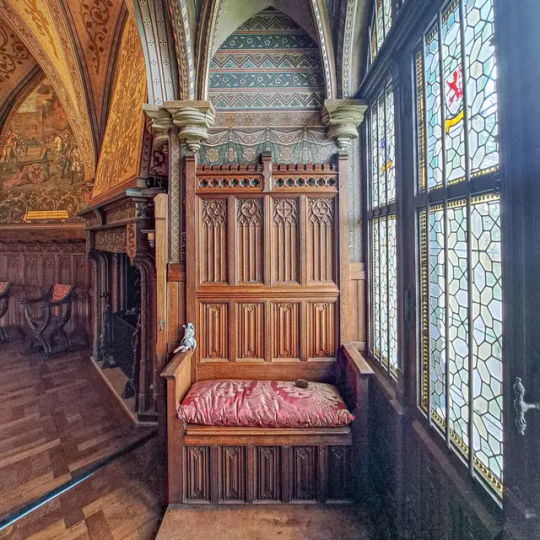
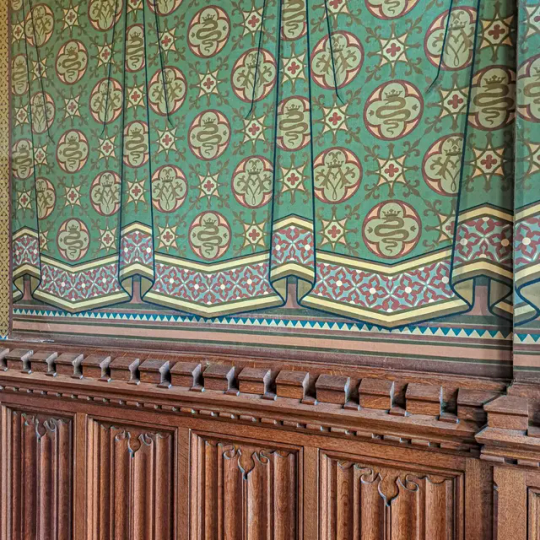
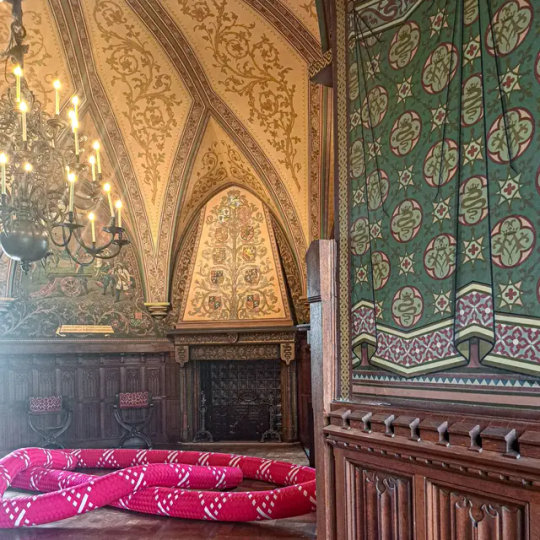
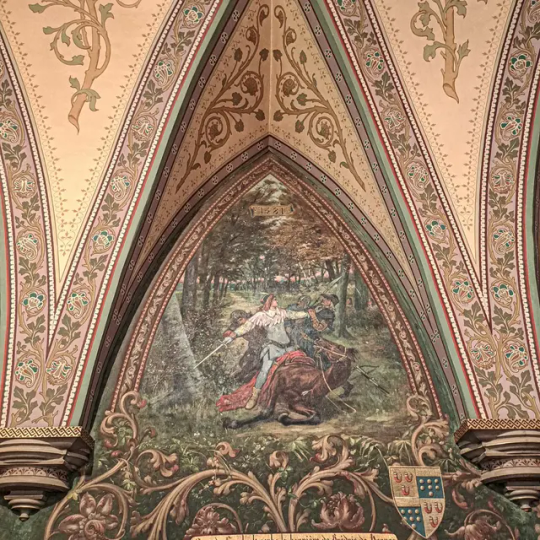
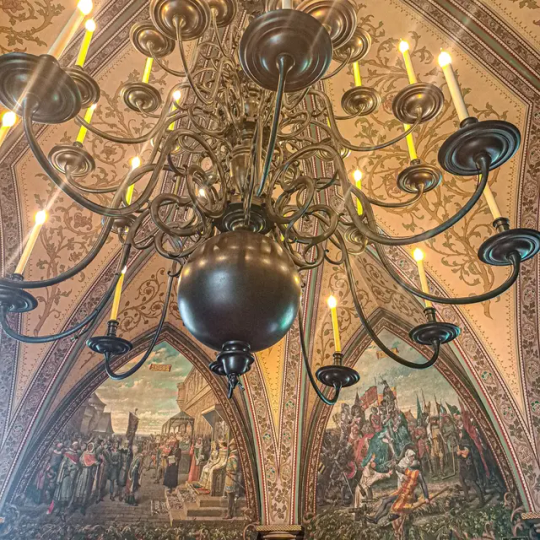
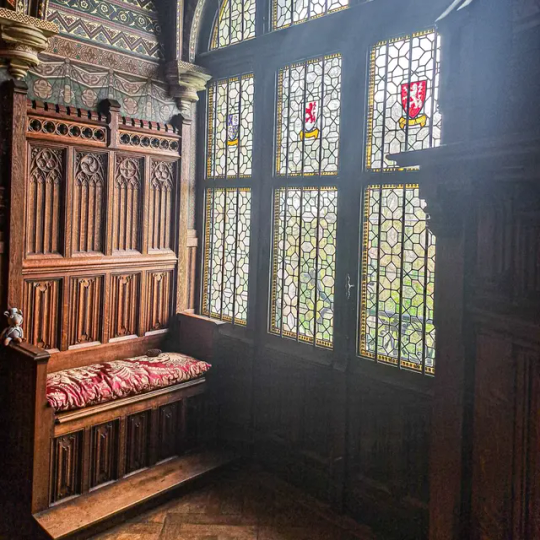


Castle of Gaasbeek , southwest of Brussels.
Explore the interior of this impressive neogothic room.
Godfrey of Leuven probably had a castle built here around 1240 to defend the Duchy of Brabant against the County of Hainaut. During the ancien régime this was the center of the Land van Gaasbeek.
In 1388, the people of Brussels razed the castle to the ground. With this they took revenge for the murder of Everaard t'Serclaes by followers of the lord of the castle, Sweder van Abcoude, who subsequently rebuilt the castle.
A number of important families from the history of the Netherlands stayed there, including the Hornes and the Egmonts. The most famous was Count Lamoral of Egmont, who bought the castle in 1565, three years before his dramatic execution.
The interior was almost completely furnished during the 19th century and furnished with copies of examples from the Paris Musée de Cluny and other important collections: mantelpieces, paneling, ceilings, doors, stairs, murals. Most were executed by the Parisian firm of Malard and in exceptional cases by Victor Rousseau.
#architecture#europe#historic buildings#architectural history#historical#belgium#history#historical interior#art history#flanders#brabant#castle#kasteel#chateau#chateaux#castillo#castello#neo gothic#gothic#gothic elegance#beautiful#beauty#ceiling#chandelier#vault hunters#exploretocreate#arquitectura#architettura#traditional architecture#belgie
16 notes
·
View notes
Text
So last night as I was starting to slowly drift off to sleep, my brain suddenly stuck on something (I promise this is Temeraire related). You see, the Netherlands have used "can't get an army across lots of water" as a basic defence strategy pretty much from Roman times until we got airplanes. The extent of it has varied; sometimes it was as simple as "well the river is too big" (Romans), sometimes it was "if we break this dike right here, the polder will flood and the Spanish can't get at the city". But, from the end of the 17th century, there was a systematic line of forts along the polders and rivers that could protect the province of Holland (specifically), here shown in purple. To the south there's big rivers leading into an estuary, and then it protects the province from invasion to the east. From about 1870, it was replaced by the orange parts, as well as the brownish line around Amsterdam specifically. The yellow area is from the mid-18th century. It is basically a collection of forts, and a series of locks. Together, these can make it so the coloured areas flood to a depth of 30-60 cm. Too deep for infantry, not deep enough for boats. It protects the capital of Amsterdam (with its important harbour), and the big cities of The Hague, Utrecht and Rotterdam.
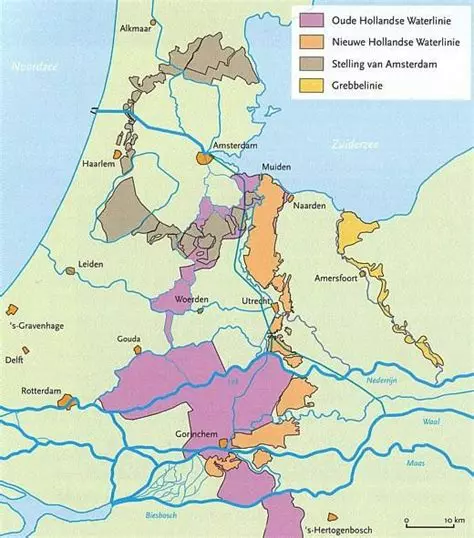
And again, until we developed airplanes and parachutists and airplane bombs and so on, this worked really well.
Now, since I've been rereading the Temeraire books, the drifting off to sleep made me suddenly realise - how would dragon aerial warfare interact with this? Which morphed into a discussion with my partner (who hasn't read the books) about how Dutch dragons would work.
The first thing I'd like to do is point out the size of the Netherlands, compared to the British Isles and to the United States:


In other words, very small. And, very importantly, it used to be even smaller; a lot of the current land was reclaimed from the sea or large lakes between roughly 1650 and 1950. Most of the west of the country is below sea level, and very wet. A fair part of the east of the country isn't very rich soils and thus not great for farming (until chemical fertiliser is invented in the 1900s) (though they did use sheep dung as fertiliser, and they would almost certainly have thought of using dragon dung as well, eventually).
So I propose that actually, the Netherlands probably would have mostly had middle- and lightweights. There just isn't the area to support a large enough population of heavyweights that they aren't all inbred. My partner suggested there is probably one heavyweight breed, and I like that idea. I think that - militarily - the Netherlands would probably have figured out a strategy for using middle-weights against heavy-weights when they are fighting alone, but preferentially use their middle-weights as support in battles when there is a larger coalition, joining whoever is on their side.
However. There may only be middle-weight dragons, there would be a fairly large number of different breeds, with different strengths. You see, unlike the United Kingdom, where England was mostly united by around 900 CE, and then the Normans strengthened that, or France, which has a similar time scale, the Netherlands is a collection of loose duchies and counties and prince-bishoprics and so on, pretty much until the 1550s. The map pictured is from 1670, after a fair amount of the lands have been united into a republic; there would likely have been more divisions before then.
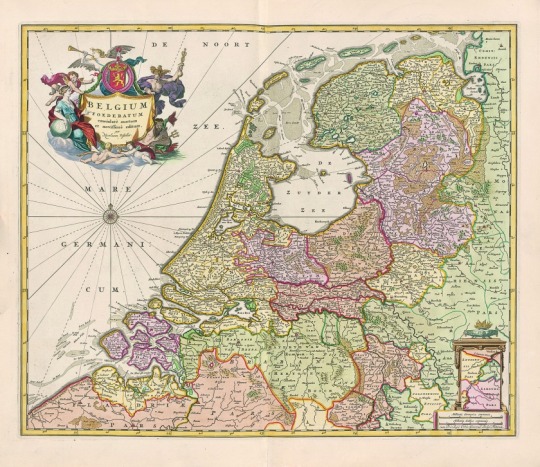
They get united under the dukes of Burgundy, eventually, but even at that time, it is still the Duchy of Brabant and the County of Holland and so on. But until they come together against Spanish rule, the separate parts regularly fight with each other. Which means that each of them would have their own breeds. (Likely, Holland and Zeeland would have very similar dragons, with aquatic adaptations, who get fed on a mixture of fish and meat; the more inland regions would have more "standard" breeds. To outsiders they all look incredibly alike, but if you mention to someone from Guelders that you cannot tell their Zwarte van Gelre apart from the Brabants Blauwtje, they would be so insulted. Can you not tell that theirs is a pure midnight black while the Brabants Blauwtje is blue? However, the breeds are so alike that most of them follow a continuum. Except the Fryske Grutskens, which looks very distinct). This is also where the single heavy-weight breed comes in - I think it would have been Flanders. Flanders is a part of the kingdom of France (rather than the Holy Roman Empire, which is the power the rest of the motley collection belongs to). One of the counts of Flanders probably got a breeding pair of heavy-weights from the king of France; maybe during one of the (many) revolts. These were crossed with the native middle-weights until a new breed of heavy-weights was developed. And finally, purely for my own amusement, William the Silent/William of Orange, who led the 1548 revolution against the Spanish, would have a dragon that is actually orange. No one knows how or why it came out that colour, none of its progenitors was, it just did and he was named for it (the fact that he is Prince of Orange is a bonus).
I also think that the Dutch would be using dragons for shipping, at least within the country. It is efficient and cheap (especially the dragons that grew up having fish as part of their diet), and the Dutch have always been fans of efficient and cheap and trade. And since it's all middle-weights, that is less scary than heavyweight breeds dropping in. I don't think dragons would be used for passenger-work, but loading the big ships, that can't quite reach the harbour? Definitely. And if you have large-ish ships, but only middle-weight dragons, it's probably much easier to ship dragons across the world, so you can also have a dragon when you arrive at your destination.
To bring it back to the idle thought that started this all - the Waterlinie, aka using the water to prevent invasion. My partner and I think it would still have worked, mostly. The Romans start taming the native European breeds, so they probably could cross the Rhine. In our world, the Rhine was the limes, the border, because they can't cross it in large enough numbers; but if they have dragons and the native Germanic tribes don't, then they can. I don't think they'd have been able to hold the land, not for long, and it's not interesting enough to bother anyway. But after that, when the playing field is levelled by everyone having dragons, the water would still be a workable defence. Yes, the aerial forces can come over and wreak havoc - except everyone has dragons now and so they will try to defend it - but the infantry still has trouble crossing the water. And then, when artillery gets developed, it's still the same. You can shoot at the enemy dragons, they can shoot at yours - and the infantry still can't cross the water. I think an enemy (often the French) would try to use dragons against the forts, before they can inundate the land, but that it wouldn't work as well after.
Anyway, here are some rambly thoughts about Dutch dragons in the Temeraire universe. (Sidenote but I can't make heads nor tails of the Dutch names that are used once or twice in the books. They just don't work.)
#lioness rambles#temeraire#many thoughts about dutch dragon breeds apparently#and some about strategy#and about history#can you tell that any time i read or reread those books my brain gets consumed by them#long post
14 notes
·
View notes
Text
Anacharsis Cloots: A Noble "Internationalist" Revolutionary, Hard to Pin Down

To this day, I still don't know if Cloots was a genuine revolutionary—both idealistic and, in a way, visionary—or a great cynical opportunist, possibly even a hypocritical revolutionary. I still can't figure him out. I once discussed Chaumette here, who I consider one of the most complex revolutionaries of this period, but at least I never doubted his revolutionary fervor. He remained clean. Cloots, however, is a different case.
Anacharsis Cloots was born in 1755 in the Duchy of Cleves. His father was an advisor to Frederick II, and his family was elevated to baronial status. He studied in France, returned to Prussia, and after his father’s death, moved back to France. He inherited an enormous fortune, largely from colonial sources. He identified as French. Cloots traveled extensively throughout Europe but hurried back when the Bastille fell. He entered political life, writing pamphlets and contributing to newspapers such as Brissot's Le Patriote Français or Desmoulins' Révolutions de France et de Brabant. He joined the Jacobin Club in 1790, proposing a motion to completely sever ties with the Church, rather than drafting a Civil Constitution of the Clergy, emulating what the Americans had done.
On June 10, 1790, Cloots presented various foreigners in support of the revolution to the Constituent Assembly, including Europeans, Arabs, and Chaldeans. He proclaimed himself the "Orator of the Foreigners' Committee" and declared that the Federation would be a celebration of the human race. According to him, “Twenty-five million free men have awakened the peoples buried in long slavery.”
He corresponded with Joséphine de Beauharnais, saying, “I was at the foreigners' celebration in the tribunes of the palace, as ambassador of the human race, and the ministers of tyrants looked at us with jealous and uncertain eyes. This national celebration transports you two thousand years back in time, by some ancient hue; it also transports you two thousand years forward, by the rapid progress of reason, of which this celebration is the early and delightful fruit.” For Cloots, the French Revolution had to extend beyond France’s borders, and in some ways, he was a precursor to internationalism.
However, he was a staunch supporter of the colonial system and was vehemently opposed to the abolition of slavery (let's not forget that his family's wealth came from the colonies, so was this cynicism, hypocrisy, opportunism, or selfishness?). During the debate between Barnave, Brissot, and Robespierre, among others, Cloots sided with Barnave. Letters have since questioned how Cloots, while claiming to be the "orator of the human race," could support slavery. Initially sympathetic to La Fayette and Barnave, Cloots later aligned with Brissot before denouncing the Girondins as enemies and even taking a shot at Marat in the process.
Cloots expressed deep hatred for the aristocracy and for Mallet du Pan, whom he grouped together with Marat, which is rather surprising. Here’s an excerpt: “March forward and we will avoid the mud of the vile Marat and the infamous Mallet du Pan.” He despised the agrarian laws proposed by revolutionaries like Momoro and later Babeuf. For Cloots, property rights were absolute (to be fair, many revolutionaries, even the so-called “enragés” or "exagérés" know as hébertists, were hesitant on this issue). Cloots believed social inequality was necessary because the rich ensured the subsistence of the poor (a summary of his thoughts by Vovelle).
After the King’s failed flight to Varennes, Cloots declared himself a republican but did not sign the Champ de Mars petition. His reasoning was that de-Christianizing the people took precedence, which seems like an odd priority compared to the petition. Here’s one of his justifications: “As long as the French attend the sorceries of the mass... it will be difficult to cure them of the deception of the royal phantom.” There were French people in favor of de-Christianization who still signed the petition, so his reasoning seems dubious. Meanwhile, Cloots argued for the abolition of nations. He initially aligned with the Girondins on the issue of war but feared the August 10th insurrection. However, after this, he distanced himself from the Girondins.
In 1792, Cloots finally obtained French citizenship. He once again attacked both Roland and Marat simultaneously. He voted in favor of the King’s death without delay, saying, "I know no other sovereign than the human race, which is to say universal reason: I say no." He also declared, "I likewise condemn to death the infamous Frederick William."
Cloots supported more revolutionary wars and aligned himself with the Hébertists, particularly due to their stance on the de-Christianization campaign. He was at the height of his glory when he became president of the Jacobins in 1793. However, revolutionaries like Robespierre began to attack him. In his newspaper Le Vieux Cordelier, Camille Desmoulins attacks Cloots (and Chaumette) "Anacharsis and Anaxagoras believe they are pushing the wheel of reason when in fact it is that of counter-revolution; and soon, instead of letting papism in France die of old age and starvation, ready to breathe its last breath without giving our enemies any advantage, since the treasure of the sacristies could not escape Cambon by persecution and intolerance against those who wish to liturgy and be liturgied, I urge to you to send a force of constitutional recruits to Lescure and Roche-Jacquelin".
Here’s an excerpt from Robespierre’s speech . When Cloots was asked where he came from, he responded that he came from Prussia, "a future department of the French Republic" in his words.
Robespierre’s attack: "Can we consider a German baron a patriot? Can we consider a man with more than 100,000 livres in income a sans-culotte? Can we believe a man who only associates with bankers and counter-revolutionaries, enemies of France, to be a republican? Citizens, do you regard as a patriot a foreigner who wants to be more democratic than the French, and who is sometimes seen with the Marais and other times with the Montagne?" He continued, "There is a third crisis that Mr. Cloots might boast of, but it will only involve fools or scoundrels. I am speaking of the movement against religion, a movement that, matured by time and reason, could have become excellent, but whose violence could bring about great misfortunes, which we must attribute to the aristocracy's calculations."
Cloots was expelled from the Jacobin Society, but he defended himself in writing, saying, "Lepeletier was once a marquis," and "if Marat had been born half a league further, he would have been Prussian." He attributed his misfortune to "loving humanity too much and not enough the cliques and personalities... France or Gaul, you will be happy when you are cured of individuals." He remained optimistic about his fate, remarking, "This speech (by Robespierre) would have had me hanged two years ago, but now it is not very dangerous in the time of organized sans-culotterie... The Abbé de Saint-Pierre was not hanged for his universal aristocracy; I will not be guillotined for my universal sans-culotterie."
However, on December 26, 1793, the Convention decreed the expulsion of citizens born in foreign countries from the national representation. Cloots was soon arrested and imprisoned. At first, he did not despair and wrote a manifesto addressed to "Hommes de bonne volonté." When Vincent and Ronsin were arrested and later released, they reportedly crossed paths with Cloots—though I would need to find the sources for that.
In any case, Cloots was brought to trial alongside the Hébertists, including Momoro, Ronsin, Vincent, Hébert, and others—some were fervent extremists, others were more dubious figures used to further discredit the Hébertists. Cloots remained very calm and defended himself the best. When a juror named Renaudin told him, "Your system of a universal republic was a deeply meditated treachery that gave the crowned heads a pretext against France," Cloots responded, "The universal republic is part of the natural order; I may have spoken of it as the Abbé de Saint-Pierre spoke of universal peace. Moreover, I can hardly be suspected of supporting kings; it would be quite extraordinary if the man burnable in Rome, hangable in London, and breakable on the wheel in Vienna were to be guillotined in Paris." Cloots faced the guillotine with great courage, urging his fellow condemned to die with dignity, reportedly in a calm tone. According to Tulard, he even made a joke to lighten the mood of the condemned, while Ronsin gave the same advice in a much harsher tone. Cloots was said to have worn a wide smile as he climbed into the cart and faced death with good humor.
So, was he just an opportunist, as Mathiez suggested? Jaurès had a great deal of sympathy for Cloots, saying he had a "warm internationalism," while Soboul referred to him as embodying a "bourgeois cosmopolitanism." Perhaps Cloots was all of these things at once, as historian Antoine Resche hypothesized.
Unfortunately, this kind of "racist" internationalism (I put it in quotes because the term didn’t exist, as far as I know, in 1790) would continue even among the most fervent figures on the left. The majority of deported Communards ( the Communards of 1870) supported the repression of the Kanaks and excluded Algerians from the fraternal republic they had dreamed of, a republic for which some had given their lives.
I’ll conclude with Antoine Resche’s excellent assessment of this figure ( in his site Veni Vidi Sensi): "Internationalist and yet a supporter of the colonial system, extremely wealthy, opposed to any form of land redistribution, yet close to the Hébertists—Cloots remains a difficult personality to pin down, but he certainly does not leave anyone indifferent."
Reddit: thanks to @anotherhumaninthisworld for finding in Camille Desmoulins' journal the passage where he attacked Cloots on dechristianization
Sources:
Antoine Resche
Jean Jaurès
Albert Soboul Anacharsis Cloots, l’Orateur du genre humain
Michel Vovelle
#frev#french revolution#cloots#robespierre#georges danton#hébertistes#josephine de beauharnais#history
8 notes
·
View notes
Photo
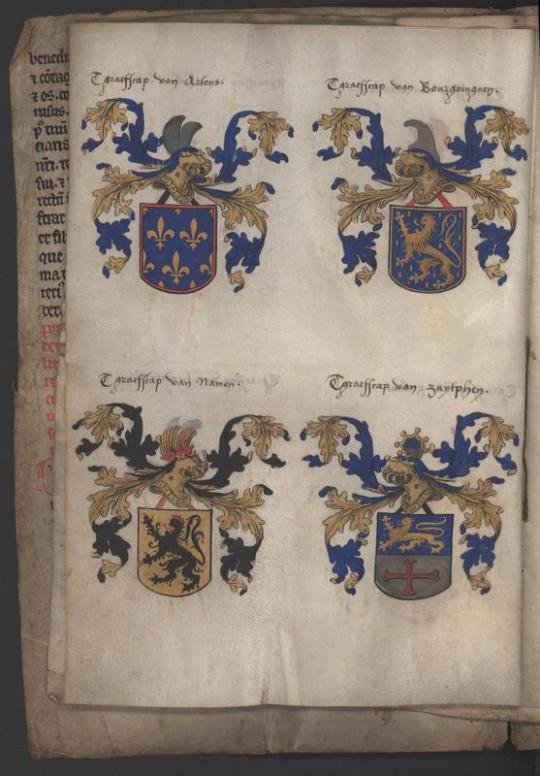



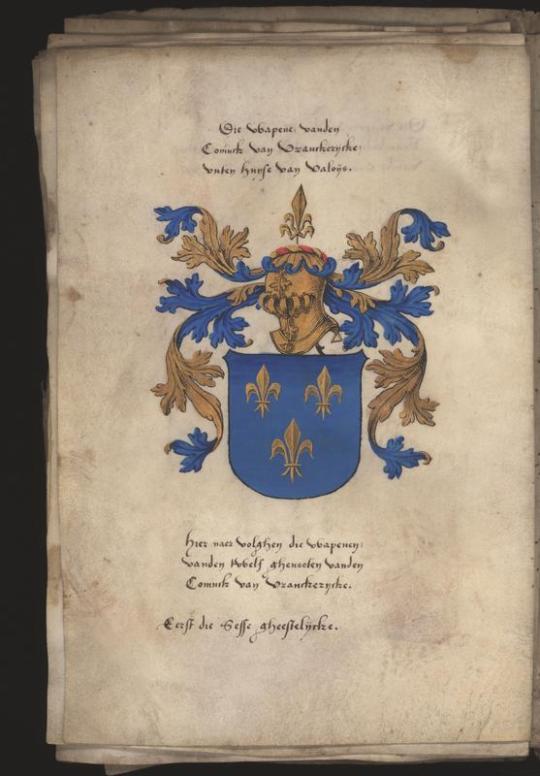
"The twelve virtues of nobility", followed by an armorial. Folio (320 x 215 mm), [24]-[2 bl.] ff. on parchment, in pen and black ink, coats of arms with watercolor. Binding: waste from a liturgical manuscript in Latin. Text: calligraphic French verse, celebrating the virtues of the nobleman: nobility, faith, beauty, honor, righteousness, prowess, love, courtesy, diligence, neatness, generosity and sobriety. The armorial is made up of 30 coats of arms with their stamps, captioned in Dutch. The first 10, in large format, relate to large sovereign houses (Holy Empire, Bohemia, Brandenburg, Valois, Saxony, etc.), the other 20, in smaller format, relate in particular to the former Netherlands (Duchy of Brabant, counties of Flanders, Holland, Zeeland, Hainaut, Namur...) and the royal houses of Valois, Aragon, Bohemia and Portugal.
(via "Les douze vertus de la noblesse", with an armo...)
#heraldry#nobility#medieval manuscripts#manuscripts#illumination#coats of arms#french#poetry#muspeccoll#mizzou#university of missouri#libraries#private collection#fb#kelli h
98 notes
·
View notes
Text
I have a question
Do you guys ever just purposefully not look for things about your favorite characters in fear that you may not truly relate to them? Well I actually have the opposite happening now. I purposefully don't look for things about my favorite character because I fear I would relate too much. Any time I see something new I'm like "Hope I don't relate because I know I will have a breakdown because of it." I swear every time I say something jokingly it becomes true. My life is quite the joke at times. Maybe it's just my amazing intuition which gets defenestrated the moment I consider talking to a person. Maybe I am just autistic and have nobody else to relate to, so when I see someone who is so incredibly similar to me in every conceivable way, I can't help but feel such extreme emotions because I have never had anyone to compare to due to my isolation. Even still I need to be thankful to isolation and autism because they created to person I am today. I could have been something so horrible if socially exposed to the people around me. Not that I hate people in general it's just where I live is definitely not the place for me. I could have ended up a stoner, a hooligan, or even a political extremist. Thank isolation for making me a socially incapable autist with a penchant for world history. I don't have friends, but I know about the ghost Kingdom of Lotharingia, or the de jure territory of the Duchy of Brabant, or the obscure Boer Republic, De Verenigde Staten van Stellaland. (My view of world history may be skewed, but isn't it skewed anyways?)
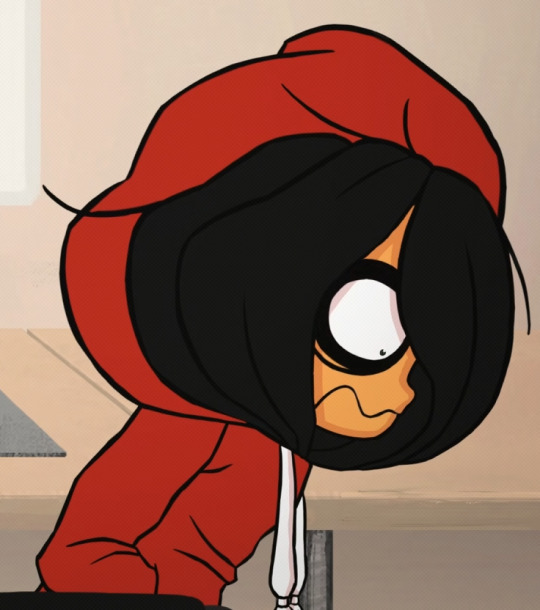
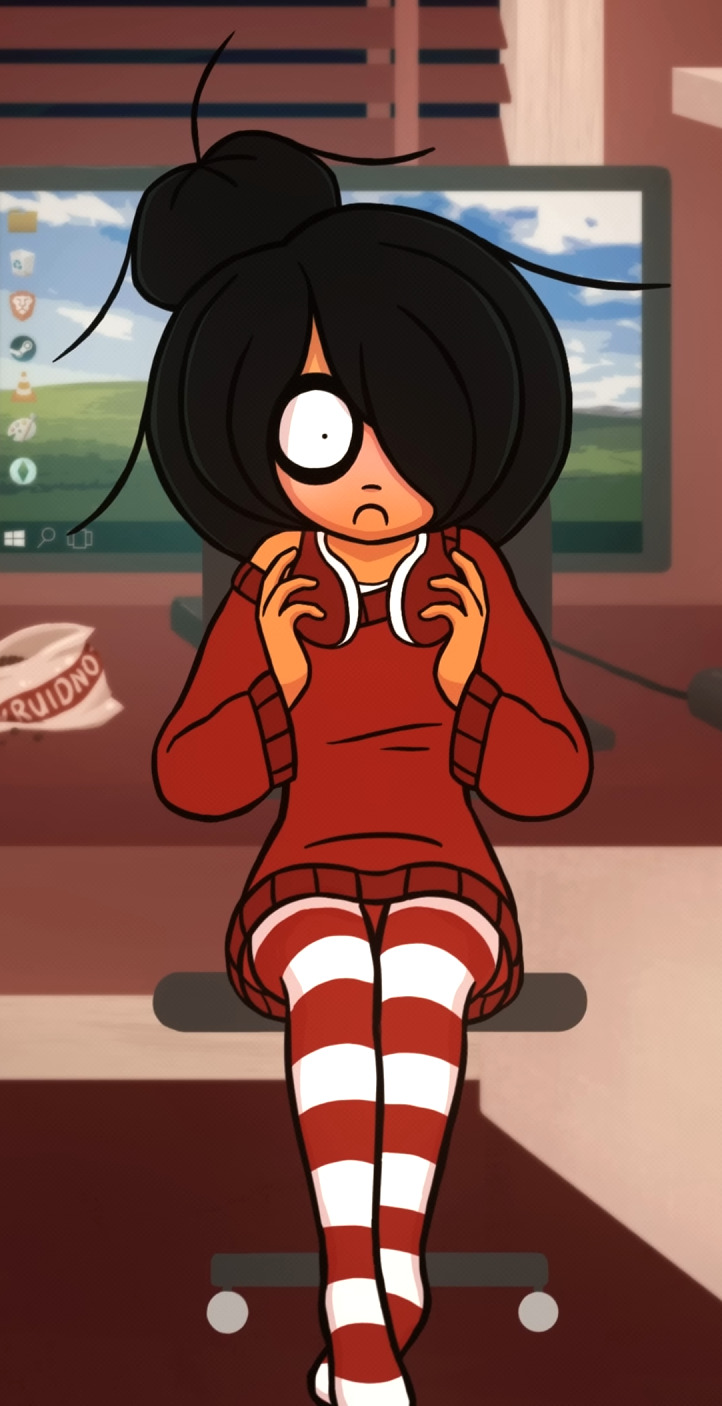
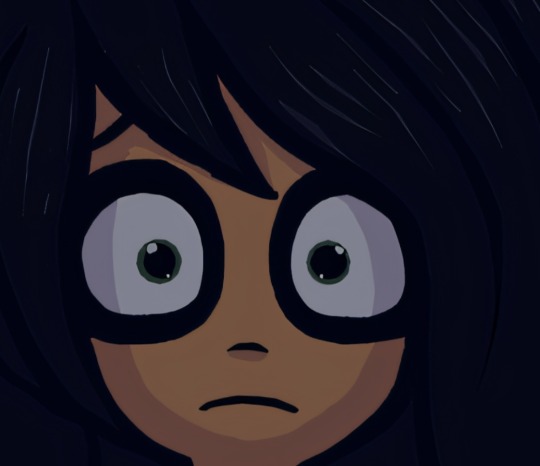
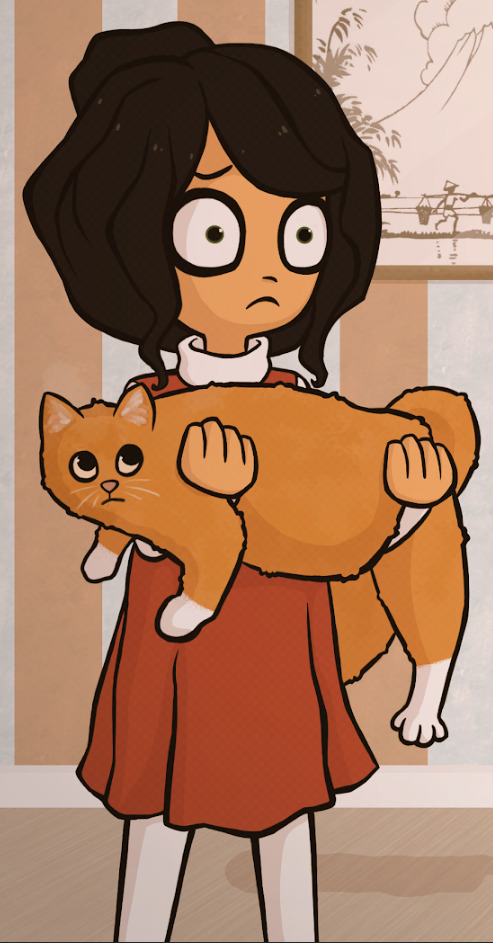
9 notes
·
View notes
Text

Visited St. Peter's Church in Leuven today, a Roman Catholic church built in the 15th century in the Brabantine Gothic style. It features a magnificent oak pulpit by the 17th century Flemish sculptor Jacques Bergé. It is an example of the naturalist pulpits produced in the Southern Netherlands (especially in the Duchy of Brabant and in Mechelen) from the 17th to the 19th century. This Baroque pulpit in oak is a total work of art of which the parts (support, bowl, staircase, soundboard) are forged into one sculptural whole. The support shows a life-size representation of Norbert of Xanten falling from a horse.





3 notes
·
View notes
Photo

La rendición de Breda
by Diego Velázquez (Sevillian, 1599 - 1660) oil on canvas (367 × 307 cm), c. 1935
Real Sitio del Buen Retiro / Museo del Prado
#Thirty Years' War#Diego Velázquez#House of Spinola#Ambrogio Spinola#Monarquía Hispánica#Spain#Duchy of Brabant#1625#June 6th#17th century#Real Sitio del Buen Retiro#Museo del Prado#military#oil on canvas#paintings
9 notes
·
View notes
Text




House of Clarillot
King Henri I of Valois, a man renowned for his strategic mind and unwavering devotion to his kingdom, sat in his grand study, his gaze fixed on a parchment map of the realm. His youngest daughter, Princess Anais, a radiant beauty with a spirit as free as the wind, was nearing marriageable age. It was time to secure a match befitting her royal status.
Duke Charles Brabant, a powerful and influential noble, had offered the hand of his eldest son, Lord Pierre, a promising young man known for his intelligence and chivalry. The alliance would strengthen Valois' position in the region and solidify its claim to the throne.
His advisors assured him that Pierre was a worthy suitor, a man of honor and integrity. With their reassurance, Henri decided to proceed with the arrangement.
A grand embassy was sent to the Duchy of Brabant to propose the marriage. The Duke of Brabant accepted with joy, eager to strengthen his own position through the alliance.





TW: Stillborn
The grand chambers of the royal palace were filled with a tense silence. Princess Emma, wife of the heir to the throne, Prince Henri II, lay on a plush bed, her face contorted in pain. This labor was unlike any she had experienced before. Hours turned into days, and the princess's strength began to dwindle.
The royal physicians, their faces etched with worry, worked tirelessly to ease her suffering and deliver her child. But the baby was stubborn, refusing to budge. Emma's condition worsened, and her life hung by a thread.
Her husband, Prince Henri, stood by her side, his heart heavy with fear. He prayed for her safety, for the life of his unborn child. The palace was filled with the prayers of the people, who held the princess dear in their hearts.
Finally, after what seemed like an eternity, the physicians managed to deliver the child. But it was too late. The baby girl was stillborn. A wave of despair washed over the room as the news spread. Emma, exhausted and heartbroken, was too weak to mourn.
With the help of her loyal attendants, she was nursed back to health. But the loss of her child left a deep scar on her heart. The palace, once filled with joy and anticipation, was now shrouded in sadness. The birth of a new princess had been eagerly awaited, but fate had decreed otherwise.
#sims 4#sims 4 gameplay#sims 4 history challenge#ts4#ultimate decades challenge#simblr#ts4 decades challenge#ts4 gameplay#ts4 legacy#ts4 simblr#royallegacychallenge#sims 4 royal simblr#royal simblr#royal sims 4#royals#sidehousehold#house clarillot#1310s#1310
2 notes
·
View notes
Text
#unhallowedarts The Tale Of Lohengrin, Wagner and the Golden Age of Illustration

“Aye , quick it is with the seeds of
change
With blessing and with bane.
But I deem it a thousand years shall run
Or ever beneath the open sun Thy voice shall sound again”
(T.W. Rolleston)
It was a knight in shining armour all right, albeit not white-steeded but pulled up the river Scheldt by a white swan, to save Elsa, ubiquitous damsel in distress, from dark Count Telramund’s cabal to usurp the Duchy of Brabant. In trial by combat, goes without saying, as it was the custom back in the days of King Henry the Fowler, which were at the turn of the 10th century when the place was part of the East-Frankish kingdom of Austrasia. Or so Richard Wagner would have it in his usually somewhat giddy take on Medieval epics and historical events. The valiant’s name, however, was Lohengrin, the one from Lothringen, Lorraine, obfuscating the man’s true origins: Lohengrin hailed from the grail castle Monsalvat, Wagner’s scene for “Parsifal” thirty years after “Lohengrin” premiered in Weimar in 1850.

Lohengrin’s mystical provenance is one of the arch-Romantic opera’s central motifs and, of course, the Germans have a word for it, “Frageverbot”, the forbidden question after the man’s origins, checking at least two of the “tall, dark, stranger” three boxes. Lohengrin is a luminous figure, but a rather sad one and the story ends in tears when the hero sails, swan-propelled, into the sunset after his work is done. Bitter, but Wagner and the zeitgeist wouldn’t have it any other way.
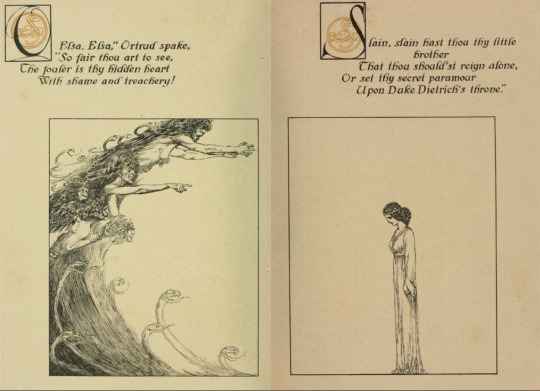
The tale of Lohengrin itself hails back to the High Middle Ages, honourably mentioned by Wolfram von Eschenbach in the early 13th century as Garin le Loherain in the minnesinger's “Parsifal”, gets two own contemporary verse epics and several variants of the swan knight theme over the next centuries until Wagner collected them all and crammed the rich material into his three hour opera, along with heroics from antiquity, elements that were perceived as Germanic paganism in the rather clouded view of the 19th century on Iron Age customs and beliefs and politics of Wagner’s own day when the Germans fought for their national unity. Along with romanticised Christian mysticism. Lohengrin is a grail knight, after all. And they do get properly married, Elsa and Lohengrin, to the sounds of “Here Comes the Bride”, no less, faithfully guided, “Treulich geführt” in Wagner’s original German from the opera’s libretto, a tune heard at the fabled joyous event across the globe ever since a Prussian royal wedding in 1858.

Wirkmächtig, efficacious, and if only for said tune, even if the topic borrowed from the old tale of Zeus and Semele, the metaphysic being hiding its true identity because the partner-to-be, as the saying goes, “can’t handle the truth” should raise every imaginable red flag, Romantic mystery or not. Even if Lohengrin reveals his true identity in the end, before his picturesque exeunt when the king calls to arms to make war against the pagan marauding Hungarians down South.
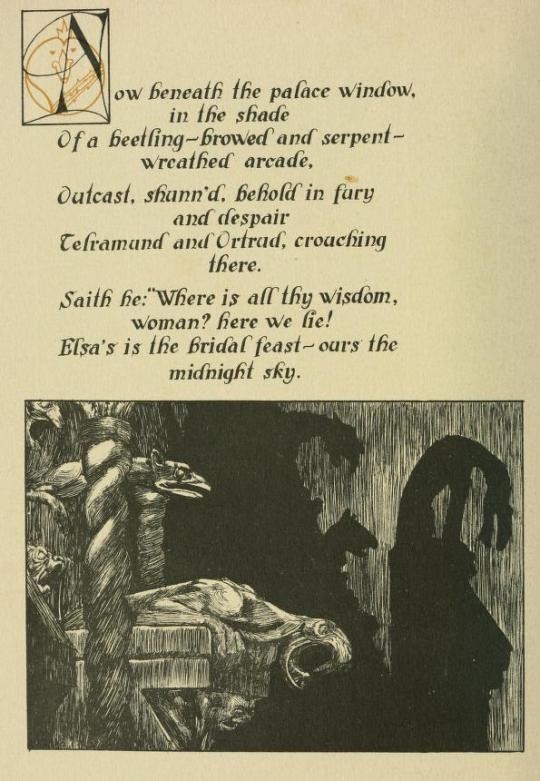
On that note, it is not without irony that Willy Pogany, born in 1882 in the back-then Austro-Hungarian city of Szeged, illustrated the tale of Wagner’s “Lohengrin” for Rolleston’s retelling with rich imagery that equals that of the better known Arthur Rackham’s of the “Ring” trilogy published around the same time. Pogany’s “Lohengrin” hit the booksellers’ shelves in 1911, along with “Parsifal” and “Tannhäuser”, when precious “gift books”, illuminated by the luminaries of the Golden Age of Illustration, were still all the rage as Christmas presents in a time when “education” was a hallmark of what passed as “better classes” back in the day.
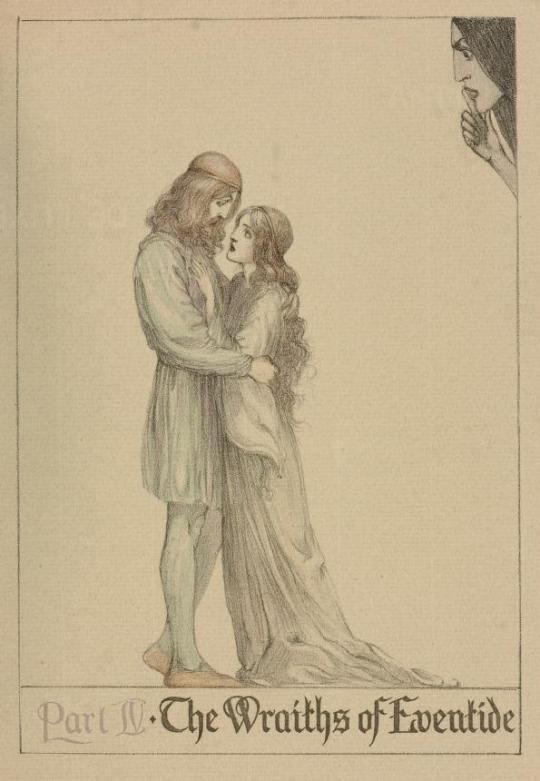
Pogany, pronounced PO-gahn, immigrated to the US before the Great War turned the world upside down in Europe, after getting properly married in London, revealing his true identity from the very beginning, goes without saying. He continued to illustrate mainly children’s books and stuck to his Art Nouveau-influenced style that sometimes reminds of Edmund Dulac, albeit with stronger lines and expressions than the Anglo-French better-known master would come up with in his dreamy takes on often the same themes as Pogany took on.
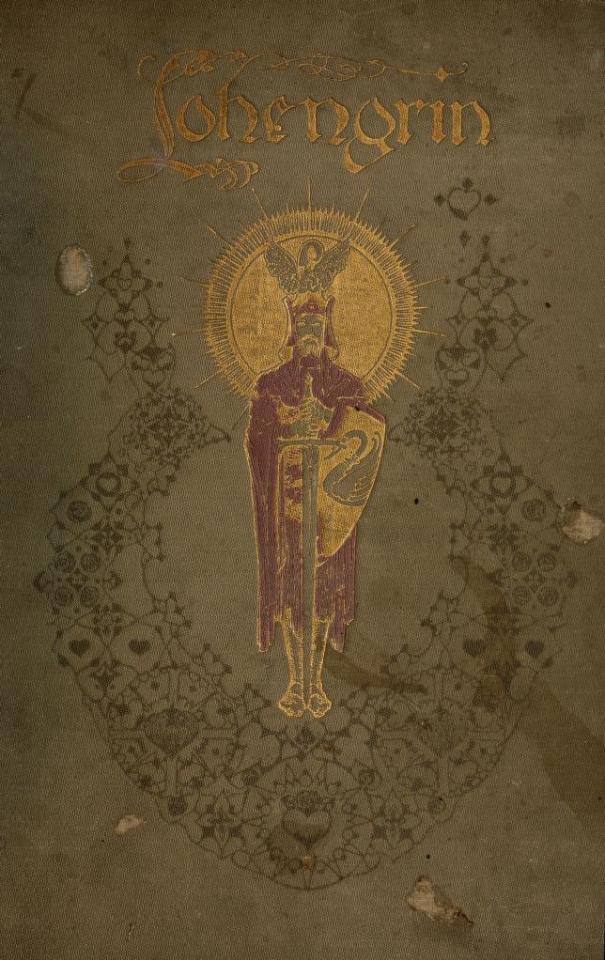
T.W. Rolleston retelling of Wagner's "Lohengrin" along with all of Willy Pogany's enchanting (and often quite dark) illustrations can be cherished following the link to a facsimile below:
#unhallowedarts#dark art#dark aesthetic#dark academia#bookart#dark acadamia aesthetic#golden age of illustration#art nouveau
37 notes
·
View notes
Text
Explaining one of VTMB paintings (pt 8)
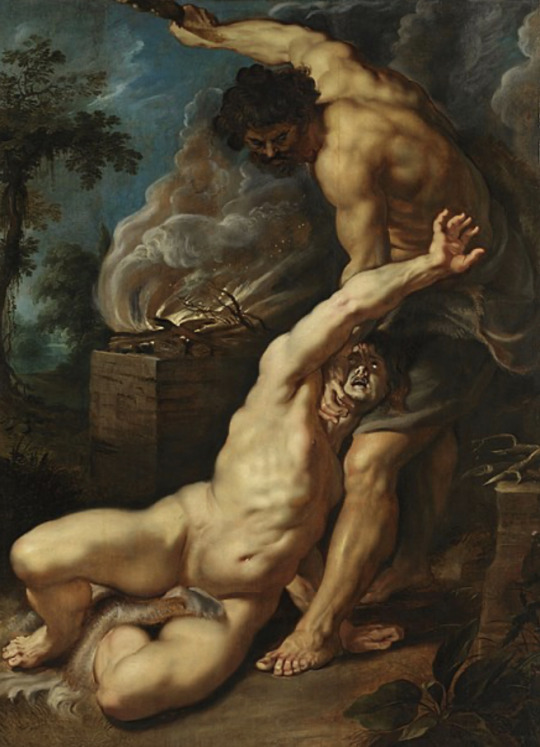
Cain Slaying his Brother Abel (Genesis 4:2-12) oil on oak wood (between 1608 and 1609) by Sir Peter Paul Rubens.
Sir Peter Paul Rubens (28 June 1577 – 30 May 1640) was a Flemish artist and diplomat from the Duchy of Brabant in the Southern Netherlands (modern-day Belgium). He is considered the most influential artist of the Flemish Baroque tradition. Rubens's highly charged compositions reference erudite aspects of classical and Christian history. His unique and immensely popular Baroque style emphasized movement, color, and sensuality, which followed the immediate, dramatic artistic style promoted in the Counter-Reformation. Rubens was a painter producing altarpieces, portraits, landscapes, and history paintings of mythological and allegorical subjects. He was also a prolific designer of cartoons for the Flemish tapestry workshops and of frontispieces for the publishers in Antwerp.[1]
The story of Baroque art in Flanders during the 17th century reflects the gradual decline of the country itself. Occupying the southern part of the Low Countries or Netherlands, it was ruled - along with the northern part of the Low Countries, known as Holland - by the unpopular Spanish Hapsburgs, who had taken over from the French Dukes of Burgundy. Its once powerful commercial and cultural centers, such as Bruges, Ghent and Antwerp, were weakened by religious and political disputes between the Catholic Hapsburg authorities and Protestant Dutch merchants. Thus while Dutch Baroque art flourished as never before, art in Flanders depended on a small handful of Flemish painters, mostly active in Antwerp.During the 15th century - the early days of the Italian Renaissance - Flemish painters had exported the technique of oil painting to artists in Florence, Rome and Venice. Now, at the beginning of the 17th century, with the spread of Italian Caravaggism, Flemish painters combined their own tradition with the tenebrist tradition arriving from Italy. This development was exemplified by the Antwerp artist Rubens (1577-1640). Since the High Renaissance, Flemish painting had been in transition between Northern and Italian influences; it was Peter Paul Rubens (1577-1640) who made the first real attempt to digest, absorb and fuse the two schools, creating a new style, well-suited to the more devout religious paintings called for by the Council of Trent's guidelines on Catholic Counter-Reformation Art (c.1560-1700), and which had a powerful impact on all painting north of the Alps.[2]
Below is an explanation of the Cain and Able story from real life and in the context of VTM. This is the same for all the Explained Cain slaying Able paintings in VTMB posts I’ve done so feel free to skip if you’ve already read this as it’s long.
___________________________________________________________
The tale of Cain murdering his brother Able are nearly identical in Jewish, Christian and Islamic texts with the oldest known version coming from the Dead Sea Scroll from the first century BCE. Cain was the the first born son of Adam and Eve and became a Farmer while Able was the second born son and became a shepherd. Both brothers made sacrifices to God, but God favored Abel's sacrifice instead of Cain's. In Islam the reason for their offerings is to decide which brother would marry Adam and Even’s first daughter who was also Cain’s twin sister. Able also had a twin sister and Adam wanted the brothers to marry the others twin. In multiple religions each brother has a twin sister but there is no consistently with the names as Cain’s twin sister being named Aclima, Kalmana, Lusia, Cainan, Luluwa, or Awan, and Able’s twin sister is named Jumella, Balbira or to make it more confusing Aclima (though even when she is called this Able’s twin sister is never the one the brothers are competing to marry) depending on the source. In the Islamic text Able’s offers his fattest sheep while Cain offered only a bunch of grass and some worthless seeds. In Jewish and Christian texts the reason for the sacrifices and the exact nature of their offerings are merely described as the first born of Ables heard and products from Cain’s fields.[3] The most description we get is in Genesis when God sees that Cain is upset that his offering was not chosen God tells Cain “: Why are you angry? Why are you dejected? If you act rightly, you will be accepted; but if not, sin lies in wait at the door: its urge is for you, yet you can rule over it.”(Genesis 4:6-7) Cain then told Able to meet him in his fields where he then murdered his brother out of jealousy by hitting Abel in the head with a stone. When God asks Cain where his brother Cain, “I do not know! he answered. Am I my brother’s keeper?”(Genesis 4:9) to which God replies “What have you done! The voice of your brother’s blood is calling to me from the ground. From now on you’ll get nothing but curses from this ground; you’ll be driven from this ground that has opened its arms to receive the blood of your murdered brother. You’ll farm this ground, but it will no longer give you its best. You’ll be a homeless wanderer on Earth.” (Genesis 4:10-12) When Cain objects saying the punishment is to great and that whoever finds him wandering shall kill him which then God says “No. Anyone who kills Cain will pay for it seven times over.” God put a mark on Cain to protect him so that no one who met him would kill him.” (Genesis 4:15). Cain then leaves east of Eden to wander in No-Mans-Land with his wife (who is not named in Genesis but is assumed to be his Twin sister in all tellings regardless of what name is given to her). Their first born Child was named Enoch, and Cain named the first city he built after his son. After Abel’s Death Adam and Eve had a Third son named Seth and when eve gave birth to him Eve said “God has given me another child in place of Abel whom Cain killed.”Genisis 4:25-26. In some texts Seths wife and sister is named Azura. Their son is named Enosh it is through Seth’s line that humanity stems from, though both Cain and Seth had multiple decedents and confusingly used the same names (see family tree below). None of Cain’s decedents suffered the curse of their father Cain but where still seen as sinful and apart from God and where killed in the great flood. How Cain died is not as an agreed upon topic. He was ether crushed to death by the stone house he built, an irony as he used a stone to slay his brother or in some versions part of the Mark of Cain had him grow horns and his descendent Lamech (not to be confused with Lamech who decedent from Seth and was the father of Noah) who was a blacksmith and had two wives(this is viewed as sinful) killed him mistaking him for a wild animal and killed his own son Tubal-cain in the process.

While in the lore of Vampire the Masquerade the tale of Cain killing his brother able as told in the Book of Nod stick to the original tale regarding the murder of Able but starts to differ in God’s punishment. "Father" cursed him with a mark, and cast him out to wander in darkness in the Land of Nod alone. There is no mention of a wife or if he was still cursed to be unable to farm however it is clear that Cain was not yet cursed to be a vampire by God. The Land of Nod was a place of utter darkness, with no source of light, where Caine was afraid and alone. There he found Lilith where they began a relationship and Cain realized that she possessed magical power and begged her to share them with him. While hesitant Lilith prepares an Awakening ceremony by cutting herself with a knife, bleeding into a bowl, and giving it to him so that he may drink. After Caine partakes of Lilith's blood, he is visited by three angels who are agents of God. Each angel offers Caine a chance to repent for the murder of Abel, but Caine rebuffed them out of pride. Michael, when denied, cursed Caine and his childer to fear his living flame. Raphael cursed Caine and his childer to fear the dawn, as the sun's rays would burn like fire. Uriel then cursed Caine and his childer to cling to Darkness, drink only blood, eat only ashes, and be frozen at the point of death, cursed so all they touch would crumble into nothing. A fourth angel, Gabriel, then appeared to offer the way of Golconda, the only way to "light", by the mercy of God. After the experience, Caine becomes officially "Awakened", possessing the following Disciplines: Celerity, Potence, Fortitude, Obfuscate, Dominate, Presence, Protean, Animalism, and Auspex. Caine then became aware of the Path of Blood, the Final Path from which all paths stem. And with all these powers, but now being cursed to be a vampire he breaks his bond with Lilith and leaves her.[3] While Cain never biologically fathers any children it is clear that their names of those he embraced and their decedents are inspired by the biblical names in his line though with massive changes. For instance the first city is founded by Cain in the land of Nod and and called Ubar and is explicitly stated to be settled by “Children of Seth” with the human king being Enoch at the time Cain settles there. Enoch still becomes his son as he is embraced by Cain. Another example of the reuse of a biblical name of cain’s line is Zillah (which in Hebrew means shade or protection). In the original story she is one of Lamech(decedent of Cain) two wives( the other named Adah). After both wives discover that Lamech unwittingly kills Tubal-Cain(one of Lamech and Zillah’s sons) they both refuse to have sex with him because of the deaths he caused, on the pretext that they do not desire to give birth to cursed offspring. The three go together to the tribunal of Adam; Adam rules that they must obey their husband since he killed unwittingly. This midrashic tradition portrays Adah and Zillah as respected women, whose position is considered in all seriousness by the court. [4] In VTM Zillah was a human woman who lived in Udar so beautiful, Caine could not resist the Embrace. According to Nosferatu Zillah is the one of Cain’s second generation who sired their Antediluvian. Interestingly, even after the Embrace, Zillah did not desire him. It frustrated Caine to the point that he was ripping his hair out of his head. He did anything and everything to make her desire him. Yet, she would not have him. Finally, Caine sought the Crone's magic, who ultimately tricked him into a blood bond, she forced the First Vampire to Embrace her. The Crone sent her new thrall away, telling him that his blood would have the power to bond others as Caine himself was bonded to the Crone. The discovery of the blood bond was what finally made Zillah agree to marry her sire Caine. [3]
[1] “Peter Paul Rubens.” Wikipedia, Wikimedia Foundation, 16 Mar. 2023, https://en.wikipedia.org/wiki/Peter_Paul_Rubens.
[2]“Flemish Baroque Art (1600-80).” Flemish Baroque Art (1600-80), ENCYCLOPEDIA OF ART HISTORY, http://www.visual-arts-cork.com/history-of-art/flemish-baroque.htm#flemishbaroque.
[3] “Caine.” White Wolf Wiki, https://whitewolf.fandom.com/wiki/Caine.
[4] Kadari, Tamar. “Zillah: Midrash and Aggadah .” Jewish Women's Archive, https://jwa.org/encyclopedia/article/zillah-midrash-and-aggadah#:~:text=Zillah%20was%20a%20wife%20of,he%20unwittingly%20kills%20Tubal%2DCain.
#VTMB#vampire the masquerade#cain and abel#sir peter paul rubens#flemish baroque art#Explaining one of VTMB paintings#VTM#Four painting for the price of one#book of nod
6 notes
·
View notes
Text
Octave Day of St John, Apostle, Notre-dame de Montaigu-Zichem / Our Lady of Sichem / Our Lady of Montaigu (474) and Memorials of the Saints - 3 January
Octave Day of St John, Apostle, Notre-dame de Montaigu-Zichem / Our Lady of Sichem / Our Lady of Montaigu (474) and Memorials of the Saints – 3 January
Octave Day of St John, Apostle Notre-dame de Montaigu-Zichem / Our Lady of Sichem / Our Lady of Montaigu (474) – 3 January: The Shrine in Brabant in the Duchy of Louvain, is a replacement of the one below Mount Garizim, Israel. Hadrian restored the temple on Mount Garizim and dedicated it to Jupiter. A small Christian community settled there and on several occasions they suffered greatly at the…

View On WordPress
#octavedayofstjohnapostle#ourladyofsichem-montaigu#saints3january#stblitmundofbobbio#stfintanofdoon#stgenevieve#stpopeantherus#thetitularfeastofthesocietyofjesus
2 notes
·
View notes